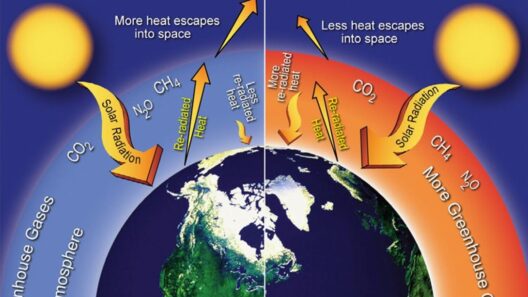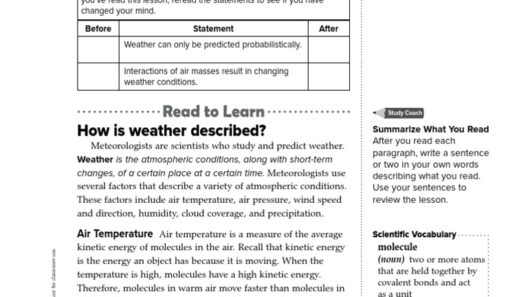The intricate relationship between climate and weather is often misunderstood. Many people view them as interchangeable terms when, in reality, they represent distinct concepts. Grasping the nuances between climate and weather is essential, not only for comprehension but also for fostering an awareness of the pressing issues surrounding climate change. This exploration will reveal the critical similarities that bind these two phenomena, inviting readers to look at them through a different lens.
To begin with, one must understand the fundamental definitions of weather and climate. Weather refers to the short-term atmospheric conditions in a specific locale at a given time, including elements such as temperature, humidity, precipitation, wind, and visibility. On the other hand, climate is the long-term average of weather patterns over a more extended period, typically considered over three decades. Most commonly, it is associated with large geographic regions, such as continents or countries, which exhibit consistent atmospheric behaviors that characterize their climates.
Though different in scope, both weather and climate share a common denominator: they stem from the same atmospheric processes. The sun, the primary energy source, plays a pivotal role in driving both phenomena. Solar radiation interacts with the Earth’s surface, leading to temperature variations that create pressure systems and, consequently, wind patterns. These wind patterns can lead to precipitation in one area and arid conditions in another, forming the weather that we experience daily. The same forces at play in shaping the weather contribute to the climate of a region, establishing patterns such as seasonal changes and long-term trends like the increase in average temperatures.
A noteworthy aspect that highlights their interconnectedness is the influence of weather events on climate change. The increasing frequency and intensity of extreme weather phenomena serve as alarming indicators of a shifting climate. For instance, hurricanes, droughts, and heatwaves are becoming more prevalent as a consequence of climate change, which thermally alters the ocean and atmosphere. As these weather events escalate, they generate feedback loops that further exacerbate climate change, leading to a vicious cycle detrimental to the environment.
The climatic conditions of a specific area can dramatically affect local weather patterns. For example, regions with a Mediterranean climate typically experience warm, dry summers and mild, wet winters, which create the perfect conditions for local flora and fauna to thrive. Conversely, areas subjected to polar climates depict a contrasting scenario, where prolonged periods of cold weather can lead to frost, snow, and ice, fundamentally affecting ecosystems. When climate shifts occur—often as a consequence of anthropogenic influences—the implications for local weather become apparent; altered precipitation patterns, disrupted seasons, and fluctuating temperatures can all drastically modify existing ecosystems.
Moreover, the interactions between climate and weather extend beyond mere academic interests; they invoke profound societal implications. For instance, agriculture is highly susceptible to both weather variability and climate change. Farmers rely on predictable weather patterns to plant and harvest their crops, but climatic shifts—including increased frequency of droughts or floods—can upset these routines and lead to food shortages. This, in turn, raises critical questions about food security and agricultural sustainability.
Urban areas, too, reveal the significance of understanding the relationship between climate and weather. Cities experience what is known as the urban heat island effect, wherein urbanization increases localized temperatures due to reduced vegetation, more concrete surfaces, and human activities. Such climatic alterations lead to modified weather patterns, challenging local infrastructure and necessitating adaptations. Without awareness of the interconnectedness of these phenomena, urban planners and policymakers may struggle to develop resilient strategies addressing challenges of climate change, such as flooding, heat extremes, and resource management.
The realm of public health is another crucial domain where weather and climate converge. Climatic shifts can influence weather-related health risks, leading to increased incidences of heat-related illnesses, vector-borne diseases, and respiratory disorders exacerbated by air quality deterioration. Understanding this interplay is vital for health professionals and policymakers to implement preventive measures and adapt health systems to cope with evolving challenges. Ignoring the intertwining relationship between weather and climate may yield detrimental consequences, endangering regions and populations vulnerable to these health risks.
Additionally, the cultural implications of climate and weather cannot be overlooked. Different societies exhibit unique adaptations to their respective climates, often influencing their customs, traditions, and even spiritual beliefs. As climate change leads to shifts in weather patterns, these cultural practices may become untenable. Communities that rely heavily on specific climates for cultural heritage, such as fishing or traditional farming methods, face the need to adapt or risk losing their cultural identity.
In summation, the interrelationship between climate and weather presents vital considerations for multiple facets of human life and the environment. The acceleration of climate change is intricately linked to changing weather patterns, revealing a complex tapestry of interactions. This awareness underscores the urgency to embrace holistic approaches in addressing climate change. Recognizing the shared attributes of climate and weather promises a shift in perspective that encourages collective action. By cultivating curiosity and understanding about these phenomena, society can better prepare for the inevitable challenges ahead, fostering resilience and adaptation in the face of an uncertain future.








